How to Fly Fish – Fly Casting For Beginners
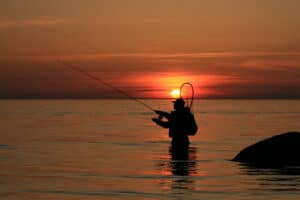
Learning how to fly fish, takes time and patience. However, there are great rewards for those who explore it.
Catching a trout, or any species on a fly is a great feeling. With fly fishing you feel like you have earned the fish. As you are actively searching, casting and reading the water. So in this article we will cover the fly casting component of how to fly fish.
(I will add more step by step images soon, so the lesson is more visual.)
Now the casting section is only a small portion of fly fishing. But if you can’t cast your line, then it is hard to fish with the fly rod. So we will cover fly casting for beginners. This will help overall your skill set on learning how to fly fish.
So how does casting work in the fly fishing scheme of things, apart from just throwing the artificial fly out into the water? It is more than just delivering the fly.
Casting is about landing the fly so that it appears to be a natural insect, landing on the water. Or being able to cast in front of the rising fish quickly and accurately.
Sometimes you need to battle into the wind, or cast, cramped in a rocky boat. Or cast under an overhanging tree branch, or go for a long distance cast, for that trout that is just out of reach.
So learning how to cast is important, but for the beginner, it can get frustrating. It might be the number one reason people give up on fly fishing.
The ability to cast, takes a lot of practice for some people.
I took several weeks of practice to get to a certain basic level. My sister on the other hand got some basics in a couple of hours. Enough, to cast out far enough to catch a fish. (How humbling, no, upsetting for me.) Every one is different, so be patience.
First rule of fly fishing, don’t give up!
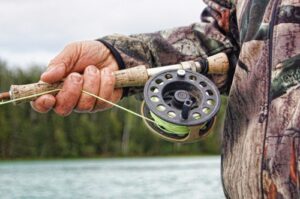
Now we have the why casting is important and the mindset to be persistent. Let’s move on.
While learning how to fly fish and cast from books, articles like this and videos are great, there is no better way than actually just doing it.
A member from the local fly club, or a fishing shop member may be able to help you with casting.
Some places have proper fly fishing casting classes that might well be worth the money.
Fly Casting For Beginners
Casting on dry land is a good way to practice.
You can cut the hook off and practice just with the shank of the fly, so you don’t hook yourself or danger any one. Wearing safety glasses can help prevent eye injuries.
Don’t practice on rough areas like gravel as this will damage the fly line. An oval or grass area where there is plenty of room for the back cast is ideal.
Tie a bit of fluorescent red, or bright yarn on your fly. This makes it easy for you to see how accurate you are casting, or not! A paper or old ceramic plate is a good target.
If you practice casting on water, some anglers use hula hoops, rings and set them at different distances.
If you are actually learning, while fly fishing and there is no activity on the water, practice aiming at small bits of leaves, insects, etc, whatever is floating past.
A little bit of practice frequently, say for twenty minutes a day is better then three hours once a week. Anyhow let’s get started.
Fly casting basics.
If you are used to spin casting, then you will know that the weight of the lure pulls the line. However, in fly fishing the weight of the line helps carry or cast the fly.
So for learning how to cast, you must use the rod to cast the weight of the fly line. We are using the rod to flex, load up and work, not just our arm. With these basic principles you will be able to progress quicker, then forcing the rod or casting like a general fishing rod.
The line follows the direction the rod tip is pointed during the cast.
Fly casting is based on timing, not on strength. Practice the timing of the cast, not brute force.
The fundamentals of good fly casting are the correct stroke and stopping of the rod. The caster loads the energy into the rod during the cast stroke.
The energy is then released by the rod into the line during the cast, slinging the line. The amount of energy loaded into the rod by the caster makes the cast.
Short casts need smaller low energy stroke. Casting arcs are small for short casts and large for large casts.
Stopping the rod after the casting stroke is important to forming the casting loop. Plus it gives the rod the opportunity to unload and cast the line.
Hopefully we understand a bit more of the way the fly rod works.
The fly casting grip.
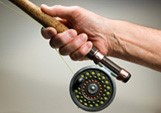
Hold out your hand as if you are going to shake someone’s hand.
Grip the rod, and place your thumb on the top of the rod grip. Some rods have a thumb impression on the grip. (Depending on the balance of the rod and reel, you may hold the rod slightly lower, closer to the fly reel.)
You will need a good grasp on the rod, so hold it firmly.
As you are learning to cast, keep the rod butt in line with your forearm. The rod needs to be in that position when you cast. If the rod deviates from that position during the cast, the tip will wander and the line will follow the tip, spoiling the cast.
How to fly fish. The first fly cast.
In this step, we are just going to lift with the rod, or flick the line off the ground and put it back down again. Below is a bit more detail on how to do it.
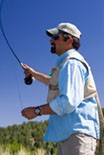
Step 1 – Lift and lay down
Assuming that you are going to practice on the lawn, strip the line straight from the reel about 12 to 20 feet (Around 3 to 6 meters.) and lay it on the lawn in front of you.
The line needs to be pulled straight on the grass with no “S” curves in it. You need the line straight for a good cast. Make sure you have room behind yourself as well.
Too much line out and it is hard to handle, not enough line and the rod won’t load up. (With a weight forward line, you need a bit of length, so the weight helps you load up.)
We are only going to lift or flick the rod swiftly backwards. Picking up the fly line off the ground sending it backwards.
Let the rod load backwards and then punch it forward. For a start we won’t be doing any false casting. (That is, casting between lifting the line from the water and landing back on the water.)
We will just get used of lifting and laying the line back down on the grass, with one cast. Lift the line off, let the rod load and lay the line down. Lift and lay down the line.
Another way to describe the action is to:
With the line laid out on the grass, hold the rod in your right hand (if you are right handed). Stand with your feet spread slightly apart.
Have the rod tip a couple of inches from the grass, straight out in front of you. It helps to think that your wrist angle, is a hand on a clock face. (The clock face is to the side of you.) Pointing the rod to the ground is roughly about 8 o’clock.
Your left hand should be holding the line firmly so no line slips out.
Now, in one swift motion, lift the rod tip up backwards from 8 o’clock and stop it firmly at 2 o’clock.
The motion should be enough to lift the line up and backwards. With the wrist stopped at 2 o’clock, the line should continue going backwards and bending the fly rod.
Pause for a brief second and wait until the line is loaded up. (The rod is flexed backwards, ready to go forward.) When the fly line is fully out horizontal, punch the rod forward.
Now stop the rod forward about 9 o’clock. (This depends on how much line you have out and how forceful your technique is.) The motion of the line will then move your angle to about 8 o’clock again.
Now you should have the line straight out on the grass again.
So lift it, stop it, pause it (loading the rod) and flick it forward. Lift it and lay the line back on the ground. Don’t worry about shooting extra line out at this stage.
To simplify things, just pick up the line, pause it and lay it down. Pick it up, pause it, lay it down. Pick it up, lay it down. Pick it up, lay it down. Just one cast, up down. Up, down.
Practice this until you get the feeling of the rod loading up. This is great practice for your timing on your back stroke.
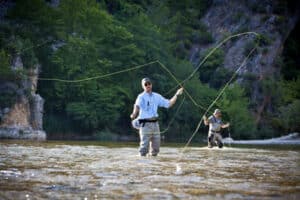
Step 2 – Lift and shoot down.
Once you have mastered picking the line up and flicking back down on the grass, we will practice shooting some line out. We are still not going to do any false casting yet.
To shoot the line out, we will follow the same technique as above. The only difference is that now you pull the line down with your left hand on the back cast (This will help load up the rod more.) and on the forward cast we let the line go.
Let’s go over the whole lot again.
With the line laid out and the tip of the rod a couple of inches from the ground, (about 8 o’clock) lift the rod tip up backwards and stop it firmly at 2 o’clock. At the same time with your left hand pull the fly line down towards your left thigh.
With the wrist stopped at 2 o’clock, the line should continue going backwards and bending the fly rod.
Pause for a brief second and wait until the line is loaded up. (The rod is flexed backwards, ready to go forward.)
When the fly line is fully out horizontal, punch the rod forward. Now with the left hand release the fly line.
Now stop the rod forward about 9 o’clock. (This depends on how much line you have out and how forceful your technique is.) The motion of the line will then move your angle to about 8 o’clock again.
Practice this again and again, until you get the timing and feeling of picking up the line and shooting it out.
Each progressive cast, you may get a little bit more length of line out. This will make it harder to pick up. If there is too much line out, just wind some in and start again.
To simplify again, pick up the line, at the same time the left hand pulls down the line, pause. Punch forward, now the left hand release the line.
Good, now we know how to shoot a bit of line out, the next step is to learn how to false cast.
How to fly fish, the false cast.
In this exercise we are not going to cast properly, not yet anyway. We are just going to learn to get the feel of the rod and fly line again. This time we are going to keep the line in the air.
Lay out some line on the grass again, standing in a balanced position. Pick the line up from the ground in one swift motion.
Flick back the rod angle and stop it at about 2 o’clock position. Pause for a brief second, until the rod loads up. (The left hand during all this can remain stationary holding the fly line if you like.)
Now punch the rod forward.
This time we are not going to lay the line down again, but stop the forward motion at 11 o’clock angle. Pause until the line is straight out front. Now flick back until 2 o’clock and repeat. Forward to 11 o’clock, pause, back to 2 o’clock, pause.
Repeat forward and back and try to keep the fly line in a tight loop. The fly line should be horizontal off the ground, back and forwards, back and forwards, etc. As you continue to flick the rod back and forth, keep your wrist firm and stop the rod sharply after each flick.

As above image. Practice this and see how long you can keep it in the air for. Make it a game and challenge yourself to see how long you can keep the fly line in the air. Without it collapsing and keeping it horizontal to the ground or water.
After a while try not to look at the rear cast and just feel the rod working.
If you get tangled, or the fly line starts touching the ground at the front or back, just stop and start over again. There is no rush.
The fly cast.
Now we have learned to lift the line up and lay it down. Also lift the lineup and shoot the line down. As well, we have learnt how to practice false casting by keeping the line in the air.
Now we are going to put it all together, by lifting the line up, false casting at the same time, shooting some line out and then shooting the line out on the ground.
With the line laid out and the tip of the rod a couple of inches from the ground, (about 8 o’clock) lift the rod tip up backwards and stop it firmly at 2 o’clock. At the same time with your left hand pull the fly line down towards your left thigh.
With the wrist stopped at 2 o’clock, the line should continue going backwards, bending the fly rod.
Pause for a brief second and wait until the line is loaded up. (The rod is flexed backwards, ready to go forward.)
When the fly line is fully out horizontal, punch the rod forward. Now with the left hand release the fly line, so it slides through your hand.
Stop the forward action of the rod about 11 o’clock and briefly pause. Wait until the fly line is fully extended, now flick he rod back to the 2 o’clock position. At the same time with your left hand pull the fly line down towards your left thigh.
We just repeat the actions another one to two times. That is on the forward cast we shoot the line out. On the back cast we load up the rod and with our left pull down beside our leg.
Try to keep it to around three false casts or less. Although it’s tempting to try and get as much line out there, the more you cast, the more chance you have of getting tangled.
To finish of the fly cast we stop the rod forward about the 9 o’clock position (This depends on how much line you have out.) and let go of the line in your left hand and let the line shoot out.
To sum it all up. Lift the line, pull back on left hand, and pause. Punch forward, let line run shoot out, pause, flick back at the same time with the left hand pull it down.
Pause, punch forward, let line run shoot out, pause, flick back at the same time with the left hand pull it down. Pause, punch forward, let the fly line go with the left hand and shoot to the ground.
It is hard to try to learn from paper, but keep practicing and remember it can take a bit of effort to learn, but it will be worth it.
Common fly casting errors.
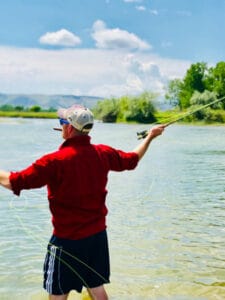
Here are some of the errors often made in casting and how to improve them.
Problem: Back cast not staying in the air and touching the ground behind.
Fault: The tip of the rod is pointing back too low, making the back cast go straight down and hit the ground. Or pausing too long.
Correction: Keep your wrist firm and stop the rod while it is around the 2 o’clock position. If you are still hitting the ground behind try sopping at the 1 o’clock position. Shorten the pause if it is too long.
Problem: Touching the ground (or water) in front.
Fault: The tip of the rod is pointing too low at the front. Or pausing too long
Correction: Keep your wrist firm and stop the rod while it is about in the 11 o’clock position. Or shorten the pause.
Problem: Distorted loops.
Fault: Putting too much force or rushing the cast
Correction: Slow down when casting and try not to use so much force. Give the line time to become completely straight after you pull the line backward before you start projecting the line forward.
If you are still getting a lot of errors and tangles, use less fly line out. Just use as much line as you can control. You will soon get better and use more line.
Other ways to learn casting.
It doesn’t hurt to have your casting critiqued by someone who is more experienced than you are. You will probably learn some pointers and much quicker.
Learn the roll cast. The roll cast is necessary when there is something behind you that would prevent you from doing a back cast. Such as trees or a dirt bank. The roll cast is also another excellent way for beginners to feel the rod action.
You can also start practicing by casting vertically, left to right of your body (side to side, instead of back to front.) as it is easy to see the line and loops of the casts.
Just make sure you wear safety glasses and a hat, as the fly is traveling past your head. Angle the cast slightly away from your body. You then might practice 45 degrees to the body then forward and backward casting.
As well as vertical casting, you can learn to do it side to side, horizontally off the ground in front of you. This is also a good way to watch the loops.
Other fly fishing casting tips.
You may not need to cast more than 50 feet (Around 15 meters.) when fly fishing, depending on target fish species, were you are fishing, etc. However, becoming proficient at long-distance cast will improve your overall casting.
Once you have mastered the shorter distance then keep adding more distances to your cast. Master a certain length before progressing to even a further casting distance.
Some beginner fly fishing mistakes are they cast too often.
It is hard for the trout to take the fly when it is in the air all the time. So time spent with your fly in the water, will increase your chances of catching a fish.
Casting for casting sake isn’t productive fly fishing. There is more chance it will scare the fish, rather than impress it!
Once you have got some solid practice behind you, the ultimate test in casting is fly fishing at night time.
Casting at night can really hone your skills, or be a disaster. Feeling the fly rod’s actions, rather then seeing it will help you improve learning how to fly fish and cast effectively.
Just be ready for a few tangles and probably a lot of cursing!
Pretty fly casting versus ugly casting, versus efficiency.
There are lots of different casting techniques recommended by the experts. If someone says you can add five yards extra to your casting distance, or pinpoint accuracy, by doing it a certain way, then take note. However, if that person recommends casting techniques that just look pretty, but have no real fishing value, take it with a grain of salt.
With all the different ways people cast, due to their body structure, preference, fly fishing equipment, it can be hard to follow someone else’s technique exactly.
As an example a five foot four, female is going to cast differently than a 300 lb., six foot two male.
If you can cast covering accuracy, speed, distance and can land the fly delicately if need be, then who cares how your technique looks.
Other important aspects of casting is economy. That is, can you cast for several hours without getting too fatigued?
The other things to consider are to make sure you are not setting yourself up for injury long term, by putting the wrist, elbow, shoulder or back into an awkward position.
While a beautiful cast looks great, does it really matter if your technique looks a bit, well, ugly? Basically you go fly fishing to enjoy yourself and catch a fish. It doesn’t really matter to the trout, salmon, or bonefish that your casting is average looking!

Conclusion – How to Fly Fish – Fly Casting For Beginners
Fly fishing is not just all about casting, such as you have your stream craft, the ability to think were the fish might be feeding, selecting the right fly and technique to name a few items. However to become proficient in it, you do have to have a certain level of skill in casting.
I hope you enjoyed this article on casting as part of the big picture of learning how to fly fish.
Extra Fly Fishing Tips and Resources:
How Do I Clean A Fly Fishing Line?
What Is A Tippet In Fly Fishing?
What Fly Fishing Gear Do I Need?
